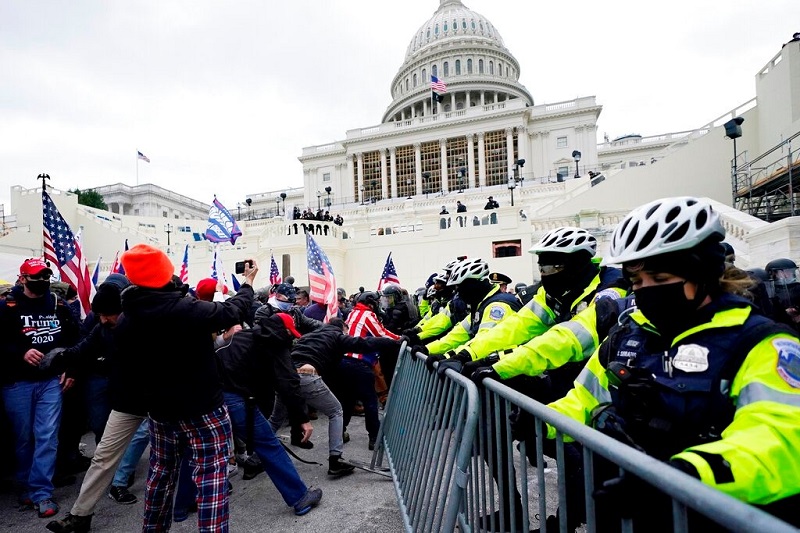
Photo credit: Julio Cortez/Associated Press
January 13, 2021
In the wake of the January 6, 2021 siege on the U.S. Capitol, Americans are understandably worried about extremism and political violence. They want to know how bad things are, and how bad they might get.
The bottom line: Although we should not panic, there’s also no excuse for ignoring an extremist threat that appears to have significant staying power. In other words, we all need to focus on the long game.
The anger and vitriol we saw on January 6 will not dissipate anytime soon.
One of the chief sources of that potential longevity is President Trump, who has provided extremists the gift of a narrative that will carry them through the next four years: a story about a stolen election, all thanks to the treasonous “left” and mainstream media, who are, as the narrative goes, suppressing the rights and voices of “real Americans.” Extremists are often animated by the angry and paranoid conviction that something sacred is being or has been taken away from them.
This rhetoric has been ramping up for years as American society has become increasingly polarized. And that means what happened at the U.S. Capitol on January 6 was in some ways the most predictable incident of political violence in American history. Anyone who had been paying attention to extremist activity across the country, or to the chorus of disinformation and hatred rampant across right wing media and its social media counterparts, could have expected it.
Most importantly, this deadly attack was not a surprise, because the President – and many of his supporters – incited it in broad daylight. Moreover, many of the people who were roused to violence that day are the product of weeks and months and years of similar incitement. They constitute a new breed of extremist, one foundationally animated by devotion to President Trump, placing him over party or country. They are living in an entire ecosphere of disinformation, lies and conspiracy theories, one fertilized by Alex Jones, QAnon, the President and his enablers, and many others.
Over the coming months and years, as they mingle with established extremists – including white supremacists, antigovernment extremists, antisemites and hardcore conspiracy theorists – these individuals could coalesce into a distinct and potent extremist movement in their own right. Alternatively, they could eventually add to the ranks of those other hateful causes.
What can we expect in coming days?
There are no hard and fast answers to that question, but there are indicators.
In the short term, there has been considerable speculation about possible extremist action leading up to the inauguration as well as on or around Inauguration Day. Certainly, the online rhetoric about the inauguration - much of which is being amplified on various online forums and social media platforms - is often violent, and some extremists seem to feel emboldened by their “success” at the U.S. Capitol. The good news is that any protests on Inauguration Day will almost certainly be much more tightly controlled and restricted than those staged on January 6. Heightened security may also suppress attendance at official and protest events alike.
There is also widespread concern over reports of potential events on or around Sunday January 17. Activists within the boogaloo movement had long planned to hold a protest that day in Washington, D.C., but it has since been cancelled. However, similar events they planned for the various state capitals do not seem to have been cancelled. To the extent that any boogaloo event takes place, it’s important to note that boogalooers, though they have a track record of violence, have a very different agenda than the pro-Trump extremists who descended on the Capitol last week. Boogalooers do not support President Trump. Their planned protests were focused on promoting gun rights and opposing what they view as government tyranny.
While the boogalooers’ D.C. protest has been cancelled, their announcement was shared widely, and ongoing online conversations about protests may attract and motivate energized pro-Trump extremists or other extreme or fringe individuals or groups. In the coming days, it is possible that extremists will turn their attention to state capitals, which are closer to home for most people. These locations have already seen protests throughout the year, including a number of anti-lockdown events which attracted some of the same people we saw in the assault on the U.S. Capitol.
The next few years will be critical in the fight against extremism and hate.
A sense of grievance lies at the heart of every extremist movement. And right now, many right-wing extremists, including white supremacists, QAnon conspiracy fanatics and anti-government militia members, believe the election -- and, more broadly, their "rights" as Americans -- have been or are being stolen by actors in a far-reaching left-wing, globalist or "Marxist" conspiracy. White supremacists and some other extremists, including Islamophobes, are also driven by manufactured fears around demographic change, which they believe will accelerate during the Biden administration, which will likely enact more humane policies towards non-white immigrants and refugees. Some extremists equate those policies to “white genocide.”
Militia and other antigovernment groups may be very active in the next few years. The militia movement has historically derived much of its energy and vitality from its rage towards the federal government. However, the movement’s support of Trump over the past few years dulled that anger. A Biden administration will allow militias to return to their foundational grievances -- that a tyrannical government in league with a globalist conspiracy is coming to enslave them by first taking their guns and then the remainder of their rights.
Finally, antisemitism will often be a central part of the conspiratorial views that fuel right-wing violence. Many of the key narratives, especially the conspiracy theories that animated the D.C. attackers, are also drivers of antisemitism. Likewise, the ongoing, high-level efforts to undermine American democracy through voter suppression constitute a threat that puts all minorities at increased risk.